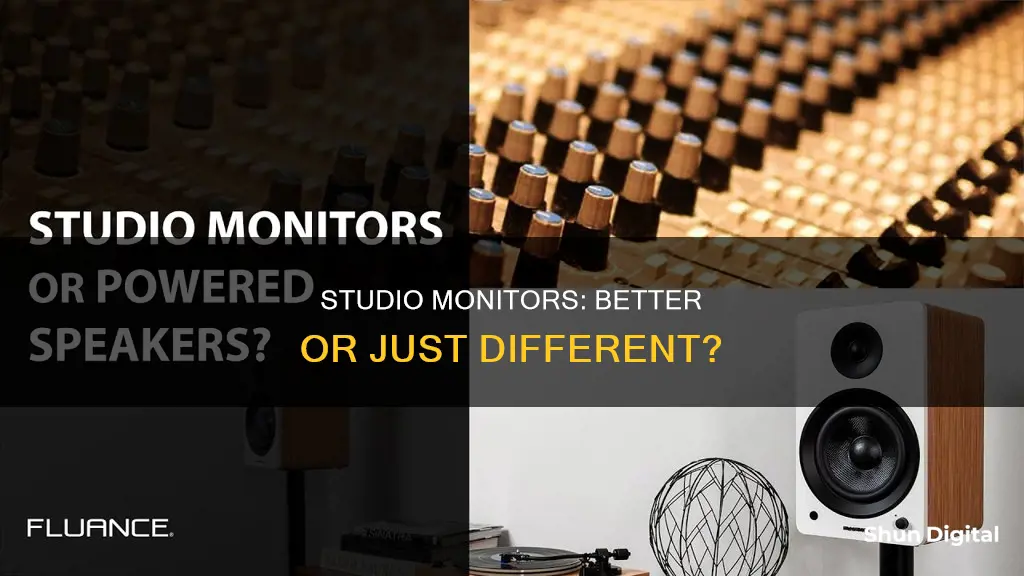
Studio monitors and regular speakers have distinct purposes and characteristics. Studio monitors are designed for critical listening during the recording, mixing and mastering process, while regular speakers are meant for entertainment and enjoyment. Studio monitors aim for a flat frequency response, allowing producers to hear the true sound without any speaker input or limitations. This means that all frequencies are played at the same volume level, in contrast to regular speakers which are often biased to emphasise certain frequencies, such as adding more bass. Studio monitors are also designed to be more accurate in reproducing frequencies, while regular speakers may add distorted noise and alter the original sound wave to increase its amplitude.
| Characteristics | Values |
|---|---|
| Purpose | Mixing and recording |
| Use | Inward-facing for musicians to hear what is being played |
| Sound | Flat, precise, accurate, true representation of the sound |
| Frequency response | Flat, no boost |
| Amplification | No |
| Speaker type | Dynamic |
| Speaker design | Two-way or three-way |
| Power | Active or passive |
| Active monitors | Built-in amplifiers |
| Passive monitors | Require external amplifiers |
| Cost | $200-$400 for beginners, $400-$1,000 for intermediate users, upwards of $1,000 for professionals |
What You'll Learn

Studio monitors are designed for critical listening
Studio monitors are designed to be as accurate as possible when it comes to reproducing frequencies. This means that they do not amplify any of the frequencies, such as bass or treble. Instead, they leave the sound wave virtually untouched, allowing the listener to hear it in its raw form. This is important for producers, editors and other musical professionals, as it gives them the tools they need to hear the sound without limitations or enhancements.
Studio monitors are placed on stands or a mixing console, with the listener seated a few feet away, at ear level. This set-up allows the engineer to hear the audio in a relatively neutral listening environment. The placement and listening position are important factors in achieving accurate sound reproduction.
Studio monitors are also designed for nearfield use, meaning they are placed close to the user/listener, giving a clear, immediate sound. This prevents the listener from hearing natural reverberations, providing a precise, upfront impression of the mix.
Blind Spot Monitor: Does Toyota's System Beep?
You may want to see also

They have a flat frequency response
Studio monitors are designed to have a flat frequency response. This means that all frequencies are played at the same volume level. In contrast, regular speakers are altered to emphasise certain frequencies, such as adding more bass to music. Studio monitors aim for a flat frequency response to give a true representation of the sound, ensuring accurate mixing and mastering.
A flat frequency response means that the output signal is as close to the input signal as possible. There is no boost or change in pitch, tone, or amplitude of the signal. This allows producers and editors to hear the sound without limitations or enhancements. This is perfect for those who work with sound or produce sound in a studio.
Studio monitors are used for the production aspects of audio products, whereas regular speakers are used for the consumption of audio products. Studio monitors are more practical for mixing and recording than listening.
Studio monitors are designed to have a flat, precise sound for nearfield use. This means they don't emphasise any one frequency, giving the most accurate impression of a mix so that imperfections can be picked out.
Studio monitors are placed on stands or a mixing console, and the listener is usually seated a few feet away, with the speakers positioned at the height of the listener's ears. This allows the engineer to hear the audio in a relatively neutral listening environment.
Monitoring iPad Battery Usage: Tips and Tricks
You may want to see also

They are used for mixing and mastering
Studio monitors are used for mixing and mastering, and they are designed to provide an accurate representation of the audio they deliver. This means musicians can hear their work as it truly sounds and make informed decisions during the mixing and mastering process. Studio monitors are built to offer a flatter frequency response, which gives listeners a more accurate representation of their music.
Studio monitors are also designed to provide more "separation" in the sounds, allowing for critical listening and mixing. This means that users can better understand how their track will play back in a room and mix at very low or extremely high levels without discomfort. Studio monitors also offer better separation and clarity than most headphones.
When choosing studio monitors for mixing and mastering, it is important to consider the size of the woofer, the physical size and weight of the monitor, the watts, and the frequency response. It is also crucial to ensure that the room where the monitors will be placed is adequately treated to avoid sound interference.
Some popular studio monitor options for mixing and mastering include the Yamaha HS5, JBL 305PMKII, KRK Rokit G4 RP7, and Adam Audio A7X. These monitors offer exceptional clarity, detailed sound, and flat frequency responses, making them ideal for critical listening and mixing applications.
Monitoring Your Child's Apple Devices: A Parent's Guide
You may want to see also

They are not ideal for everyday listening
Studio monitors are designed to deliver sound with high fidelity, giving you an unaltered version of the original recording. While this level of authenticity is ideal for audio professionals, it may not be ideal for everyday listening. Here are some reasons why:
They can be too revealing:
Studio monitors are designed to provide an accurate and transparent representation of the audio, exposing every nuance in a track, including imperfections. While this is essential for audio production work, it may be too much detail for casual listening. Some recordings may have flaws or imperfections that become more noticeable when played back on studio monitors, which can detract from the enjoyment of the music.
They may not be as engaging:
Some studio monitors can be sterile and lacking in character, which can lead to listener fatigue. Regular speakers, on the other hand, may enhance certain frequencies or add their own "flavour" to make the music more appealing to the average listener. Studio monitors may not provide the same level of enjoyment for everyday listening as they are designed for critical audio work.
They can be expensive:
Great studio monitors tend to be very expensive, especially if they are powered. This can be a significant factor for those who are not audio professionals. While there are budget-friendly options available, it is important to ensure that they still meet the critical listening needs and provide a good listening experience.
They may not be suitable for all environments:
Studio monitors are typically designed for near-field listening, which means they are ideal for shorter listening distances and minimising room acoustics interference. In larger rooms or spaces with acoustic issues, studio monitors may not perform as well as regular speakers, which are often designed to sound good in a variety of room sizes and shapes.
They may require more technical knowledge:
Setting up studio monitors correctly requires a good understanding of room acoustics and optimal placement. This may involve creating an equilateral triangle with your head and the two monitors, avoiding walls and corners that can amplify bass frequencies, and investing in acoustic treatment to improve sound quality. Not everyone may have the knowledge or resources to optimise their studio monitor setup for everyday listening.
In conclusion, while studio monitors can provide an accurate and detailed listening experience, they may not be ideal for everyday listening due to their revealing nature, lack of engagement, high cost, limited suitability for all environments, and the technical knowledge required for optimal setup. Regular speakers may be more suitable for casual listeners who are looking for an enjoyable and tailored listening experience.
GPS and Blind Spot Monitoring: Safety Features Explored
You may want to see also

They are used for production, not consumption
Studio monitors are used for production, not consumption. They are designed to have a flat frequency response, meaning all frequencies are played at the same volume level. This is important for accurately balancing the levels of different frequencies when mixing. Studio monitors are also designed to be as accurate as possible when reproducing frequencies, which is crucial for producers, editors, and other music professionals who need to hear the "true" sound without any speaker input or limitations.
Regular speakers, on the other hand, are designed to emphasise certain frequencies, such as adding more bass or treble to music, to create an enhanced and enjoyable listening experience. They are typically used for playing back music and other audio for music enthusiasts to enjoy.
Studio monitors are also designed for critical listening, allowing producers to pick out sonic imperfections so they can be fixed. They are often used in recording studios, radio stations, and other professional audio environments for mixing music, dialogue, and sound effects during the recording, mixing, and mastering processes.
Studio monitors tend to be active, meaning they have built-in power amplifiers, while regular speakers are usually passive, receiving power from a dedicated standalone amplifier. Studio monitors also tend to have multiple power amplifiers in one unit, allowing for more precise sound. They are typically placed on stands or a mixing console, with the listener seated a few feet away, to create a neutral listening environment.
In summary, studio monitors are designed for production and accuracy, while regular speakers are designed for consumption and enjoyment. Studio monitors provide a flat, precise sound for nearfield use, making them ideal for critical listening and mixing, while regular speakers are designed to sound good in any space and can be used for casual listening.
Removing Philips Monitor Stand: A Step-by-Step Guide
You may want to see also
Frequently asked questions
Studio monitors are used for the production aspects of audio products. They are used to mix music, dialogue, and sound effects during the recording, mixing, and mastering process.
Studio monitors are designed to have a flat frequency response, meaning all frequencies are played at the same volume level. This is important for accurately balancing the levels of different frequencies in the audio. Regular speakers, on the other hand, are designed to emphasise certain frequencies, such as adding more bass, to create an enhanced listening experience.
Studio monitors are specifically designed for critical listening and identifying sonic imperfections during the production process. They provide a more accurate sound for recording, mixing, and mastering. Regular speakers, while not ideal for production, are designed for enjoying music and can be used in a variety of settings, from home audio systems to entertainment venues.
Studio monitors are designed for production rather than consumption. They are built to provide a flat, precise sound for nearfield use, meaning they sound best when listened to from a few feet away. Regular speakers, on the other hand, are designed to project sound in a broader direction and can be enjoyed from various locations in a room without significant sound quality degradation.







